OCR A level Biology - Transport in plants
1/39
There's no tags or description
Looks like no tags are added yet.
Name | Mastery | Learn | Test | Matching | Spaced |
|---|
No study sessions yet.
40 Terms
Explain the need for transport systems in multicellular plants
SMALL SA/V ratio, long distance from outer surface to cells so diffusion insufficient. BIG w/ a HIGH METABOLIC RATE. Thus, plants need transport systems to ensure nutrients reach all tissues.
Describe the structure & function of the vascular system in roots of dicotyledonous plants
Xylem vessels arranged in an x-shape in centre of vascular bundle, surrounded by phloem. This provides support to withstand pulling forces which roots are exposed. Vascular bundle surrounded by endodermis which is an out layer of cells which supply xylem vessels w/ water. Inside layer of the endodermis is a layer of meristem cells called pericycle.
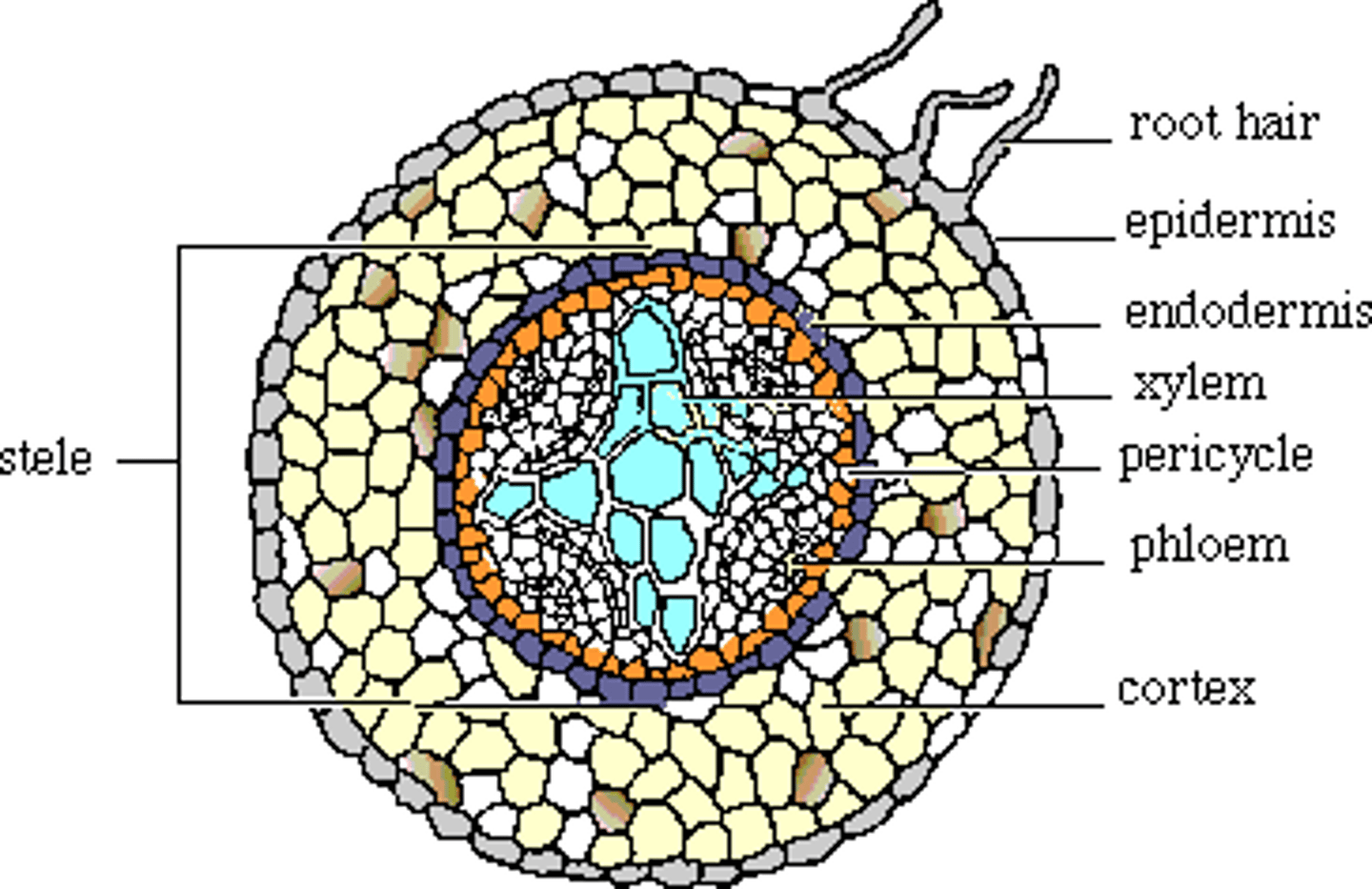
Describe the structure & function of the vascular system in stems of dicotyledonous plants
Vascular bundles located near outer edge of stem. Xylem found towards inside of each vascular bundle & phloem towards outside. Arrangement provides strength and flexibility to withstand bending forces that stems & branches are exposed. Layer of cambium in between xylem and phloem which is a layer of meristem cells that divide to produce new xylem & phloem tissue.
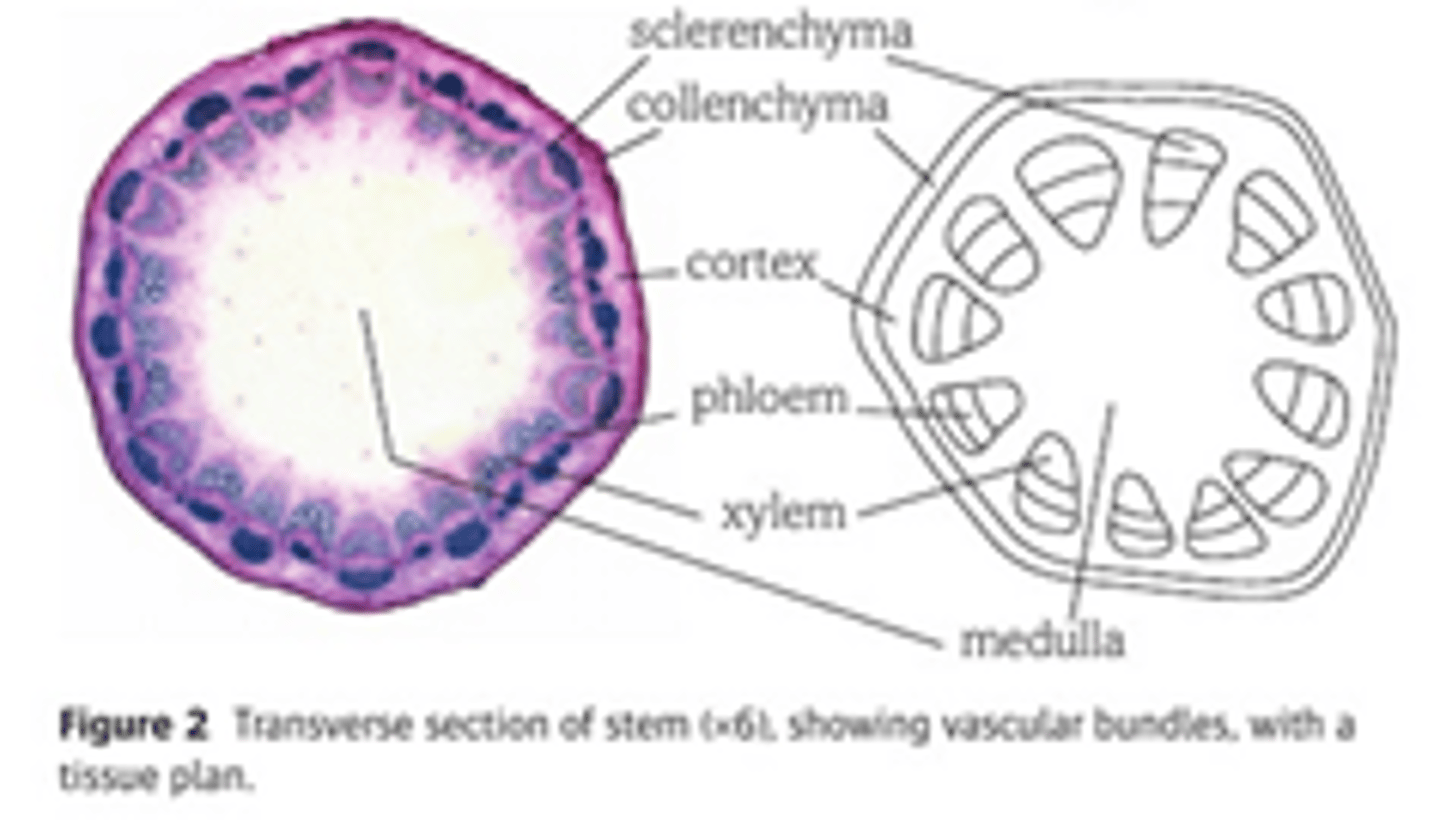
Describe the structure & function of the vascular system in leaf of dicotyledonous plants
Vascular bundles form midrib & veins of a leaf. Dicotyledonous leaves have a branching network of veins that, starting at midrib & spreading outwards. These are involved in transport and support of leaves.
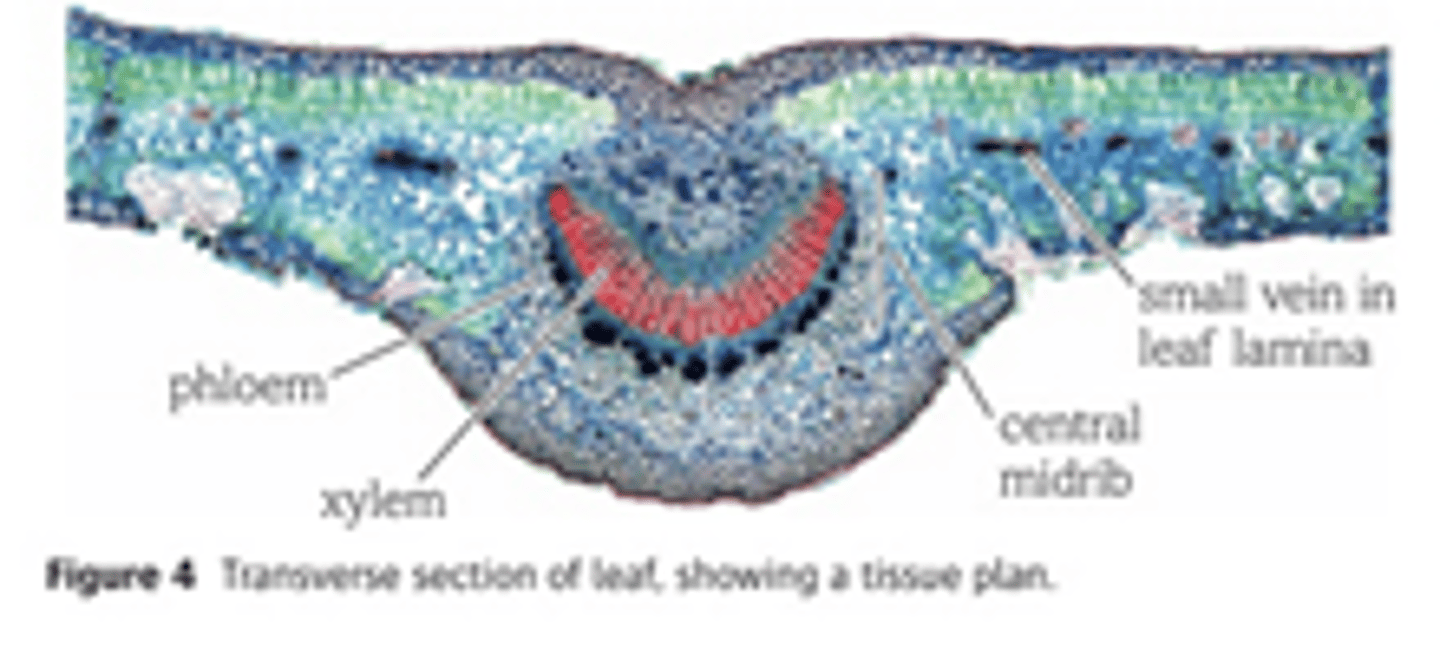
Outline what is meant by dicotyledonous plants
Plants w/ 2 seed leaves & a branching pattern of veins in their leaves.
What is the vascular bundle?
Xylem tissue & phloem tissue
Dissection of plant material
1)Cut a cross-section of a leaf stalk using a scalpel
2)Place section on a slide, add stain like TBO. Cover w/ a coverslip & observe using a light microscope.
Describe the function & structure of xylem vessels
Transport water & mineral ions from roots to leaves. Made from dead cells (no cytoplasm/ nucleus) aligned end to end & no end walls on cells so this forms a continuous column to allow water to pass through middle. Thick walls strengthened w/ lignin which helps support & prevents xylem from collapsing. Bordered pits allows water to move between vessels & supply water to other vessels.
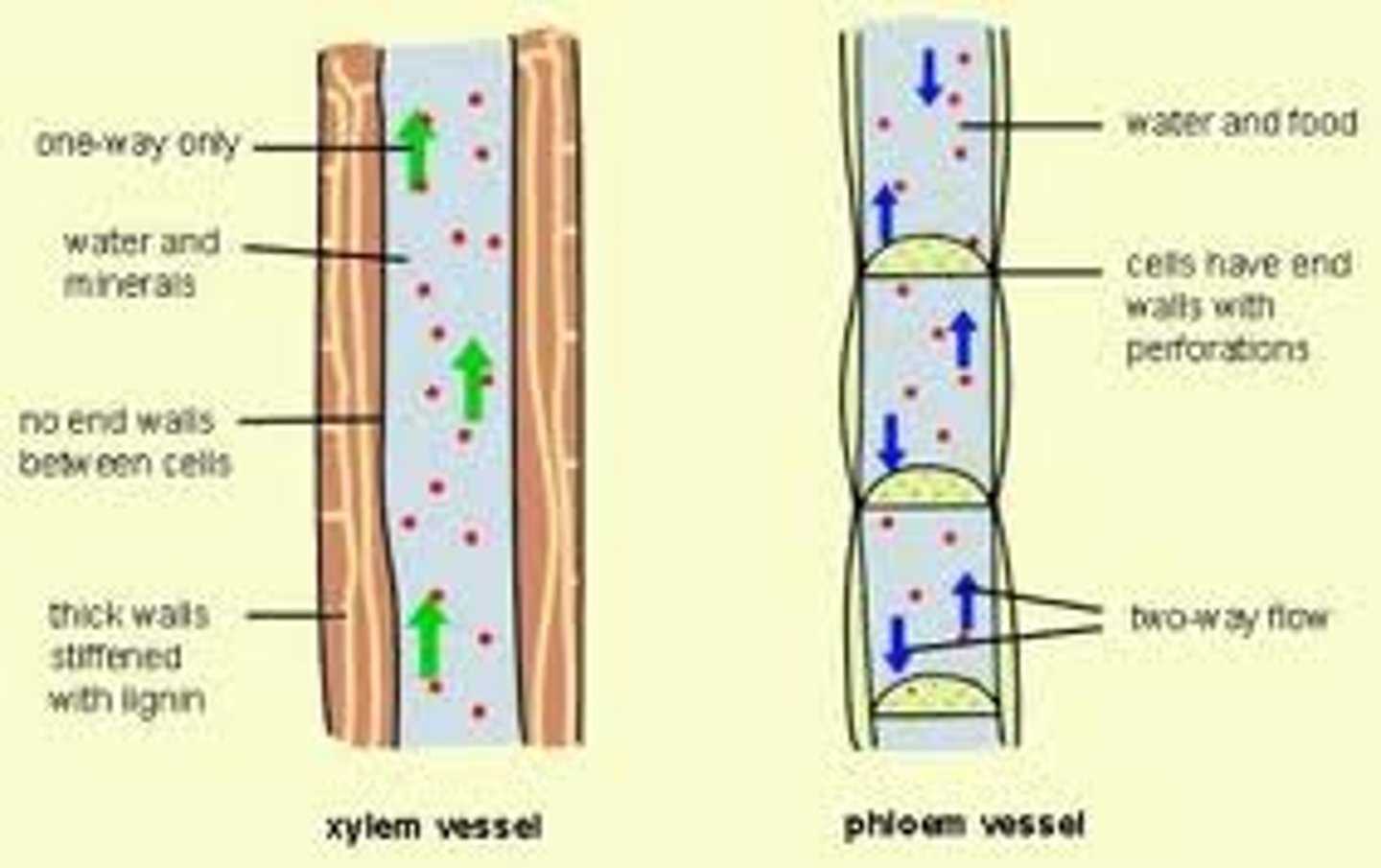
Describe the function & structure of the phloem tissue
Transport assimilates (mainly sugars & amino acids) around plant. Sieve tube elements are living cells joined end to end to form sieve tubes. Contain no nucleus & little cytoplasm which leaves space for mass flow of sap to occur. Have end walls
Describe the structure and function of companion cells
Located between sieve tubes. Contain nucleus & many mitochondria to produce ATP needed for active transport.
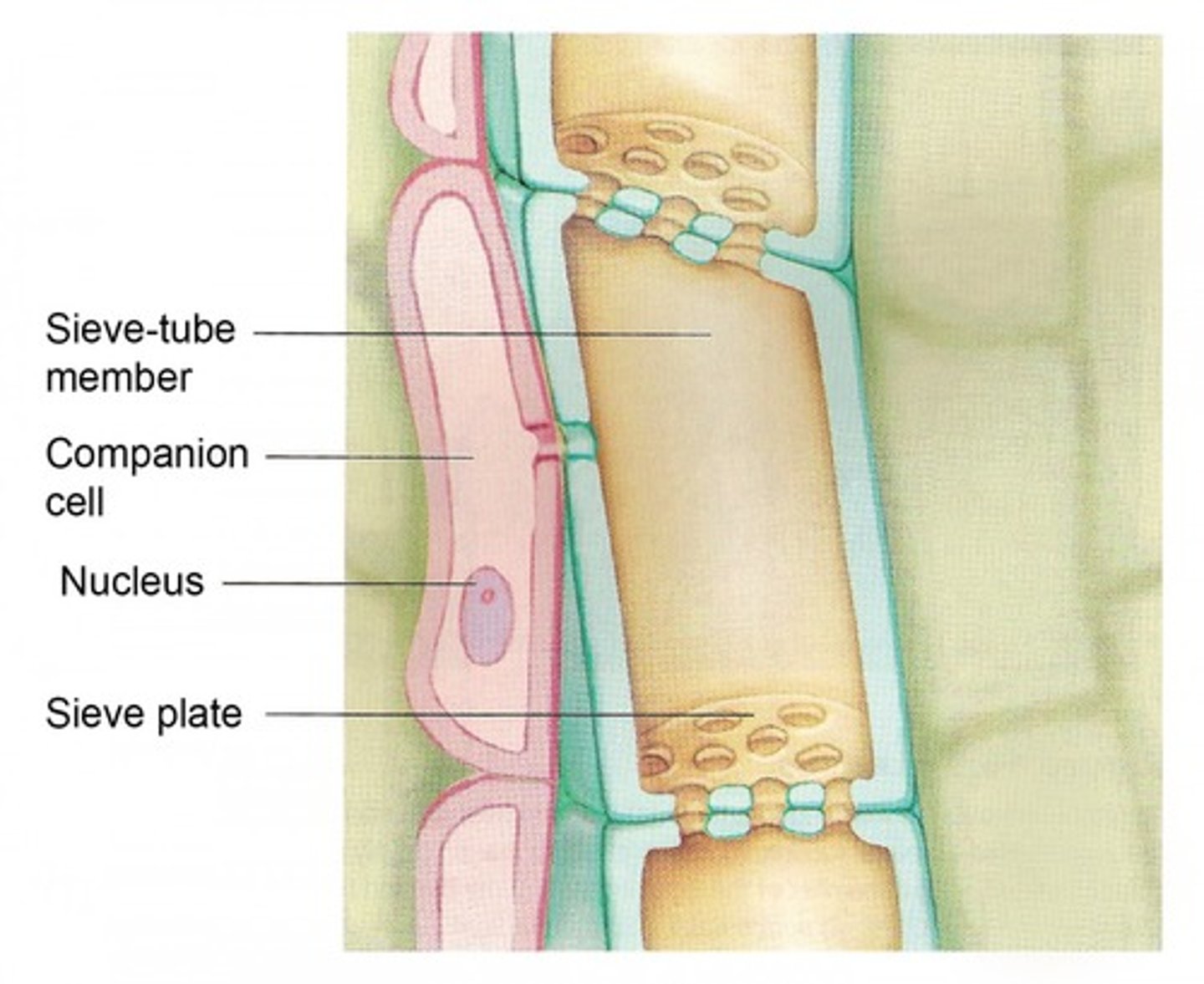
Describe the structure and function of sieve tube elements
Lined end to end to form sieve tubes. At their end are end walls that contain lots of holes to allow movement of solutes through. They have no nucleus, thin layer of cytoplasm & few organelles.
Outline what is meant by transpiration
the loss of water vapour from the aerial parts of the plant, mostly via the stomata in the leaves.
Explain the process of trasnpiration
- Water enters leaf through xylem, and moves by osmosis into cells of spongy mesophyll. It may pass along walls via apoplast pathway.
- Water evaporates from cell walls of spongy mesophyll
- Water vapour potential in leaf is higher than outside, so water molecules diffuse out of leaf through open stomata.
Explain why transpiration is a consequence of gas exchange
Plant needs to open its stomata to let CO2 in so it can produce glucose by photosynthesis. Water evaporates out as there's a higher water potential inside the leaf than in the air outside. Thus, water moves out of the leaf down the water potential gradient as the stomata opens.
Explain how light affects the transpiration rate
The higher the light intensity, the faster the transpiration rate as the stomata opens in light to allow gaseous exchange for photosynthesis. When dark, the stomata usually closes, so there's little transpiration.
Explain how temperature affects the transpiration rate
Higher the temperature, faster the transpiration rate. Water molecules gain more kinetic energy, so they evaporate from cells inside leaf faster. This creates a water potential gradient between the inside & outside of the leaf, causing the water to diffuse out of the leaf faster.
Explain how humidity affects the transpiration rate
The lower the humidity, the faster the transpiration rate. Air around the plant is dry, water potential gradient between leaf & the leaf increases so transpiration increases.
Explain how the air movement affects the transpiration rate
The more air movement, the faster the transpiration rate. Air moving outside the leaf will carry away water vapour that diffused out of the leaf. This will maintain a high water vapour concentration gradient.
Measuring the transpiration rate using a potometer.
1)Cut a shoot underwater to prevent air entering the xylem. Cut it at an angle to increase the surface area available for water uptake
2)Assemble potometer in water & insert shoot underwater so no air enters.
3)Make sure apparatus is watertight & airtight.
4)Dry leaves, allow time for shoot to accumulate & then shut the tap.
5)remove end of the capillary tube from the beaker of water until one air bubble formed
7)Record starting position of air bubble.
8)start a stopwatch & record distance moved by bubble per unit time.
What is a potometer?
An apparatus used to estimate the transpiration rate. Measures the rate of water uptake by a cut shoot.
Outline the importance of transpiration.
- Transports useful mineral ions up the plant
- maintains cell turgidity
- supplies water for growth, cell elongation and photosynthesis
- supplies water to keep the plant cool on hot days as it evaporates.
Describe the pathway by which water is transported from the roots to the xylem.
Water & mineral ions are absorbed from soil by root hair cells through osmosis from a high water potential to a more negative water potential.
Water enters root cortex via the apoplast pathway between cell walls, the symplast pathway through the plasmodesmata and vacuolar pathway.
Water enters endodermis that has a casparian strip that blocks apoplast pathway so water transported by symplast pathway allowing selective mineral uptake.
Water enters xylem and minerals are moved using active transport which reduces water potential in xylem creating a water potential gradient. Water can't enter root cortex again as endodermis blocked.
Outline what the casparian strip is
waterproof strip found in endodermis. Blocks apoplast pathway so water & ions have to be transported by symplast pathway. It's responsible for selective mineral uptake and controls water potential (lowers water potential in xylem so water moves up xylem.)
What is the apoplast pathway?
Water moves through spaces in cellulose cell walls and between cells. Water doesn't pass through any plasma membranes into cells, meaning water moves by mass flow than osmosis. Dissolved minerals and salts carried w/ water.
What is the symplast pathway?
Water enters cytoplasm through plasma membrane then through plasmodesmata from one cell to the next.
Outline what is meant by the plasmodesmata
gaps in cell wall containing cytoplasm that connects 2 cells.
What is the vacuolar pathway?
Water not confined to cytoplasm, water can move through vacuoles.
Describe the mechanism by which water is transported from the root cortex to the air surrounding the leaves (transpiration stream)
Minerals are actively transported into xylem vessels. Lowers water potential in xylem and water follows by osmosis.
Root pressure pushes some of water upwards.
Water evaporates from leaf's surface by transpiration & water is lost.
Water must be replaced as water moves out xylem into leaf. Creates low hydrostatic pressure & a pressure gradient & thus tension
Water molecules are attracted to each other by forces of cohesion which creates a continuous column of water so water can be moved by mass flow, pulled upwards by tension from above.
Water molecules are also attracted to xylem walls by forces of adhesion and causes capillary action.
Explains what happens when a plant cell is placed in pure water
it will take up water by osmosis, since water potential is lower inside plant than outside so water moves down concentration gradient through osmosis. Cell becomes turgid.
Explain what happens when a plant cell is placed in a concentrated salt solution
Loses water by osmosis, water potential of cell is higher than of the solution so water moves down water potential gradient out of cell. As water loss continues, cytoplasm and vacuole shrink, cytoplasm no longer pushes against cell wall and is not turgid. Cell becomes plasmolysed.
What is a hydrophyte?
a plant adapted to living in water/ where ground is very wet.
What is a xerophyte?
a plant adapted to living in dry conditions
Describe how the xerophytes like marram grass are adapted to the water availability in their environment
- thick waxy cuticle on upper epidermis, reduces evaporation.
- leaf rolled up which traps moist air, reducing water loss from leaf.
- stomata in pits in lower epidermis which help reduce air movement and loss of water vapour.
- spongy mesophyll very dense w/ few air spaces, less SA for evaporation of water
- stomata located on inner epidermis so they're protected by enclose air spaces.
Describe how the xerophytes like cacti are adapted
- have spines than leaves, reduces SA of leaves so less water lost by transpiration.
- thick waxy cuticle on upper epidermis to reduce evaporation
- close their stomata on hottest times of day as there's more transpiration which creates a steep water potential gradient.
Describe the adaptions of hydrophilic plants
- many large air spaces in leaf, to keep leaf afloat so they're in the air and can absorb sunlight.
stomata on upper epidermis, they're exposed to air to allow gaseous exchange.
- leaf stem has many large air spaces to help w/ buoyancy & enables oxygen to diffuse quickly to roots for aerobic respiration.
- flexible stems and leaves, supported by water so don't need rigid stems. Flexibility help prevent damage by water currents.
Outline what is meant translocation
movement of assimilates (sucrose) throughout the plant.
What is a sink?
part of plant where assimilates are used/ stored
What is a source?
where assimilates are made
Active loading
ATP is used by companion cells to actively transport H ions out of their cytoplasm & into surrounding tissue.
Creates a concentration gradient as there's more H ions outside cell than inside, so H ions diffuse back into companion cells through special cotransporter proteins.
These proteins allow H ions to bring sucrose molecules into companion cells.
As sucrose conc increases inside companion cells, they diffuse in sieve tube element through plasmodesmata.
Movement of sucrose along phloem by mass flow
(AT SOURCE) Active transport used to actively load sucrose into sieve tubes of phloem at source. This lowers water potential gradient inside sieve tubes, so water leaves tubes by osmosis. Creates high hydrostatic pressure inside sieve tubes at source.
(AT SINK) Solutes removed from phloem to be used up, increases water potential inside sieve tubes, so water leaves tubes by osmosis. Reduces hydrostatic pressure in sieve tubes at sink.
(AT PHLOEM) Results in pressure gradient from source to sink. Gradient causes solutes to move along sieve tubes to where they're needed. Water entering phloem at source, move down hydrostatic pressure gradient & leave phloem at sink which produces a flow of water along phloem (mass flow)